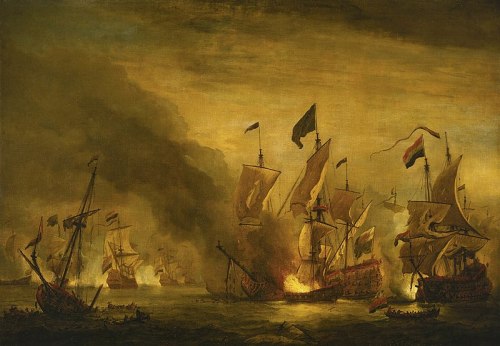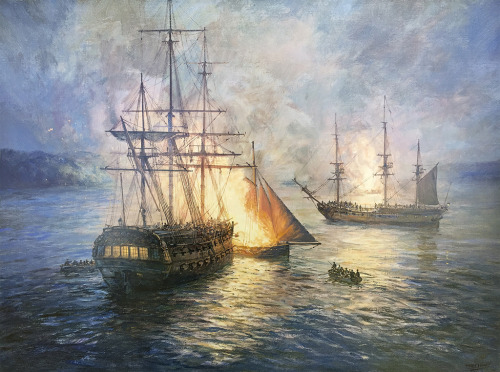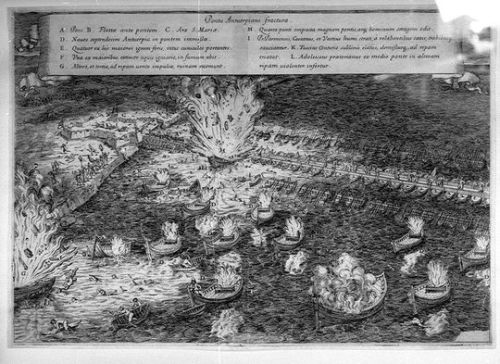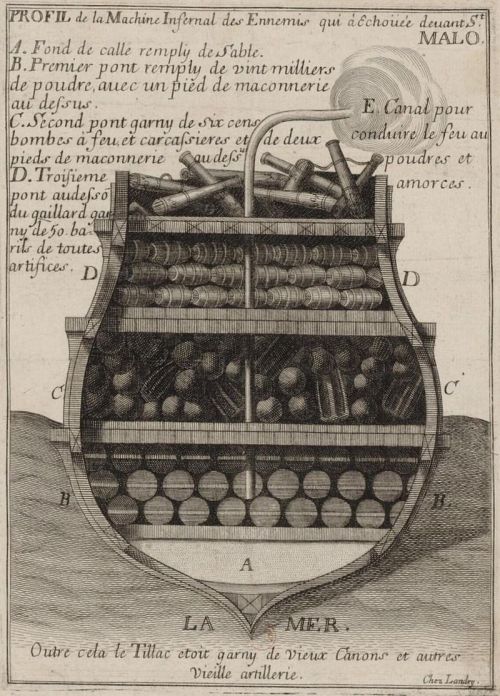Fireships
They were already used in ancient times, the first missions being known from the Athenian expedition to Sicily (415-413 BC) and the siege of Tyros (332 BC). And even in China in 208 A.D. the use of them during the batlle of the red rock was documented. But its main use was from the 13th to the 19th century. While only used sparingly during the Napoleonic Wars, fire ships as a distinct class were part of the British Royal Navy until 1808, at which point the use of permanently designated fire ships attached to British squadrons disappeared. Fire ships continued to be used, sometimes to great effect, such as by the U.S. Navy at the Battle of Tripoli Harbor in 1804 and by the British Navy’s Thomas Cochrane at the Battle of the Basque Roads in 1809, the very last mission was probably during a battle during the Greek War of Independence 1821-29.Because for the most part they were considered an obsolete weapon by the early 19th century.

The Defeat of the French Fireships attacking the British Fleet at Anchor before Quebec City. 28 June 1759.
Structure and Function
Mostly small, old or retired ships like the pinasse or the sloop were used, but also larger ships could be used as we can see it on old paintings. A so-called fire chamber was installed on board the respective ship, which was mostly closed below deck between bow and main mast by a bulkhead or a shed from the other rooms. The combustion chamber was filled with bundles of reed grass, hemp heaps, shavings, tow and bush branches, all of which were covered with flammable liquids.
On a framework or gangboards, wooden tubes or gutters were laid in several parallel rows over the entire length and width of this combustion chamber, resin-coated from the inside, which were connected to each other and in which the running fire required for the ignition of the main burning material ran along. On each side of the fireman there were usually five to six hatches closed by flaps which, in contrast to piece ports, could be opened from top to bottom by a hinge attached to the underside. In front of each of these closed hatches, a ten-inch iron tube with a five-inch diameter, closed at the rear, was installed, which can also be called a chamber gun. These chamber guns were loaded exclusively with powder and a wooden plug was driven into the tube in front of the propelling charge. In use, the chamber guns were later fired by the ignited barrage via a fuse in the ignition hole, so that the previously closed hatches were blown open by the shots and the additional fresh air that flooded the combustion chamber could provide more activity for the spreading conflagration.

Dutch fire ship attack on the English flagship Royal James at the Battle of Solebay (1672) by Willem van de Velde the Younger
Below the main and forestay shrouds, vertical tubes were installed in the firebox, under which a fire barrel stood. These tubes were covered with wooden plugs and a tarred tarpaulin on deck to prevent unintentional ignition or ignition by the enemy. Immediately before the ignition both were removed, so that the fire ignited in the fire chamber could spread over the vertical tubes fast at the shrouds and at the remaining rigging of the fire ship.
The fire barrels as well as the aforementioned fuel materials such as bushes, chips, reed grass, etc. were dunked in ethyl alcohol and sprinkled with fine gunpowder with a cotton fuse and could thus be ignited with a time delay.
In the upper deck there were also two further small hatches, through which the ignited fire could also spread well on deck, especially as the upper deck planks were specially resin-coated for this purpose.

The Burning of a Turkish Frigate, Constantinos Volanakis
On the sides of the fireman, pieces of canvas, so-called fire shirts, mixed with sulphur and gunpowder, were hung, which could be ignited with a pistol shot.
Since a fire could not be controlled and ignited by a single person, there were also crew, officer and captain’s cabins on board, which were located in exactly this order behind the closed firebox and in which the ship’s crew was accommodated according to their rank. Tradition has it that the crews of 10 to 12 sailors received double pay due to the high degree of self-endangerment.
Fireships were used particularly successfully against anchoring fleets,
as they could not get to safety quickly enough. Sailing fleets sometimes
had to perform breakneck evasive manoeuvres for the same reasons. Thus
the order of an attacked fleet could disintegrate, which often led to
defeat. A well-known example for this is the fate of the Spanish Armada,
which had to accept a defeat against an English fleet equipped with
only eight fire ships.
The effect of fireships could be more
devastating than gunfire, as the rigging, sails and hulls of the wooden
sailors were often bone dry and sealed with tar against moisture.
Completely undamaged ships could therefore be almost completely on fire
in a few minutes and had to be abandoned.

Fireships on the Hudson River, by Geoff Hunt
In the battle, the fireship went behind the line(s) of the own warships. This usually prevented him from being ignited by enemy fire before he was deployed. The ship was equipped with grappling hooks at the cams and sailed during the battle towards the enemy. On the way there the protective covers of the vertical tubes and the fire barrels were removed and thus made ready for action.
The fireship then sailed through his own lines towards a certain ship and ideally hooked the grappling hook on the enemy ship, while his own crew also tried to moor on the enemy ship using grappling hooks. The ideal position for a fireship attack was a bow-to-bow position, as the enemy could not reach the burning fireship and countermeasures were hardly possible. If the fire had come close enough to the enemy or had even managed to moor, the captain ignited the two tubes with the wildfire and went with the rest of the crew via a hatch near the tube into a longboat and rowed away hastily.
The flames of the burning fireship, who was hooked to the outer wall of the destroyable ship, then spread to the enemy ship and ideally made it unfit to fight or manoeuvre. Often the action ended with the total loss of the enemy ship if the fire could not be extinguished in time and reached the powder chambers. To prevent a fireship from setting oneself on fire, i.e. when evasive manoeuvres with one’s own ship or sinking attempts by the fireman were unsuccessful or impossible - fire hooks were used. Fire hooks were strong trees or spires that were spread through the piece ports to prevent the fire from getting stuck to the hull of the ship. However, it was most expedient to send out armed dinghies in the direction of the fire ship and to hijack this or the longboat of the enemy.
Special types
Dutch Hellbranders,
were first mentioned in the chronicles of the siege of Antwerp in 1584/1585. On 5 April 1585 they were deployed on the Dutch Schelde off Antwerp against Spanish troops. Constructed by the Italian war builder Federigo Giambelli, they were used here against a ship blockade bridge reinforced with garrisons.
Although it was not possible to destroy the bridge and restore the navigability of the river, one of the unmanned Hellbranders ran up against a part of the bridge near the garrison there and exploded here. The explosion and its consequential damage apparently killed nearly 1000 soldiers in one fell swoop.

An engraving entitled “Pontis Antwerpiani fractura” showing the blowing
up of Parma’s pontoon bridge, used in the siege of Antwerp in 1585.
Print from a book by Famiano Strada, 1623
An English infernal machine or hellburner,
was an armoured fire ship, which was further developed by the English on the basis of Dutch design patterns of Hellbranders and first used in St. Malo on 27 November 1693. The aim was to destroy the fortified city of St. Malo with such a ship, but this was not possible because the unmanned infernal machine ran aground before reaching the fortification walls. Another use of English infernal machines became known during an attack on a pier in the French port of Dieppe in 1693 during the Nine Years’ War.

Section of a infernal machine with its various explosives and firing system. French print, circa 1692-1693
Rocket ships,
I had already written about them in a separate post. This can be read here again.
Structure and Function
English infernal engines as well as Dutch infernal burners were ships loaded with the fuels usual for fire ships. In addition, they were also equipped with a considerable number of black powder barrels in the combustion chamber and thus represented floating bombs, which were detonated by a combined clockwork and flintlock mechanism or another ignition delay mechanism.
In addition to the fuel and explosion materials described above, there were also scrap metal parts (e.g. ploughshares), gravestones and marble balls on board, which had a kart-like function due to the explosion of the black powder barrels and could therefore result in severe or even fatal injuries, if these were accelerated by the shock wave directly on people in the vicinity of the explosion or simply rained down. Buildings and fortifications could also be seriously damaged. The upper deck of the ships was often still covered with granite slabs, so that on the one hand a protective function against enemy fire was given and in the context of the intended explosion granite splinters or hitting whole granite slabs had correspondingly damaging effects on the enemy.
In addition to the devastating consequences of the explosion, the fuel originally loaded on the ships also caused additional fires to break out in many places on the periphery of the explosion site.













